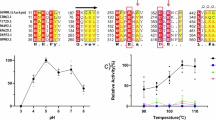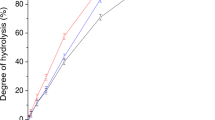Abstract
NATURAL starch is a mixture of two components, which can be separated in a number of ways although it is doubtful if complete separation has yet been attained. The names, amylose and amylopectin, used earlier in a different sense, may be conveniently retained to describe the two components. Amylose, forming about 25 per cent of whole starch, is constituted of unbranched chains of glucose residues, the members being mutually linked by α-1: 4-glycosidic linkages. Amylopectin possesses for the most part the same 1: 4 glucose linkages and forms about 75 per cent of natural starch, but its chain structure is branched or laminated through the lateral linking of its shorter lengths of 1:4 glucose chains by certain α-1: 6-glycosidic bonds.
This is a preview of subscription content, access via your institution
Access options
Subscribe to this journal
Receive 51 print issues and online access
$199.00 per year
only $3.90 per issue
Buy this article
- Purchase on SpringerLink
- Instant access to full article PDF
Prices may be subject to local taxes which are calculated during checkout
Similar content being viewed by others
References
Hanes, C. S., Proc. Roy. Soc., B, 128, 421; 129, 174 (1940).
Haworth, W. N., Heath, R. L., and Peat, S., J. Chem. Soc., 55 (1942).
Hassid, W. Z., and McCready, R. M. J. Amer. Chem. Soc., 65, 1159 (1943).
Author information
Authors and Affiliations
Rights and permissions
About this article
Cite this article
HAWORTH, W., PEAT, S. & BOURNE, E. Synthesis of Amylopectin. Nature 154, 236 (1944). https://doi.org/10.1038/154236a0
Issue date:
DOI: https://doi.org/10.1038/154236a0
This article is cited by
-
Phylogeny and expression pattern of starch branching enzyme family genes in cassava (Manihot esculenta Crantz) under diverse environments
Molecular and Cellular Biochemistry (2015)
-
Histochemical studies on the distribution of some enzymes of the glycolytic pathways in the olfactory bulb of the squirrel monkey (Saimiri sciureus)
Histochemie (1967)
-
A Simple Method for the Preparation of Crystalline Potato Phosphorylase and Q-Enzyme
Nature (1953)



